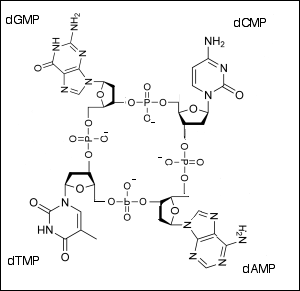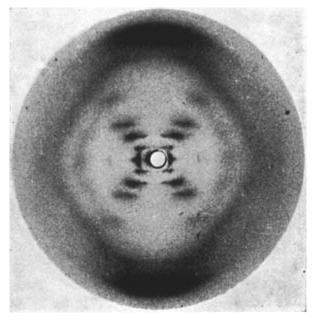Searching for the function of DNA
From the year 1869, when Friedrich Miescher discovered DNA, it took almost a century of research of its chemistry before the discovery of the structure in 1953. In the 1940s scientists still commonly regarded DNA as a small and a rather insignificant molecule.
Around the turn of the 20th century, several scientists had found the two pyrimidines (C, T) and the two purine bases (A, G) be present in nucleic acids in equal quantities(a). These results probably led Levene and Bass in 1931(15) to propose a tetranucleotide hypothesis. The hypothesis stated that nucleic acids consist of four fixed order repeating nucleotide units.

Today, we know that DNA is double-stranded. If there is a base T along one of the strands, the opposite DNA strand position will always carry a base A. Likewise, a base G pairs with C; Therefore, DNA has equal amounts of T and A and equal amounts of G and C, assuming that there are no errors. Having this knowledge, we understand that the tetranucleotide hypothesis was false.
In contrast to nucleic acids made out of only four bases, proteins were known as giant macromolecules, consisting of 20 different amino acids and folding into specific three-dimensional structures; thus, gaining specificity to binding other molecules.
It was certainly challenging to conceive the possibility that only four repeated bases as building blocks of relatively short nucleic acids were enough to form numerous complex three-dimensional structures. A multitude of variations of three-dimensional arrangements would be necessary for the transfer of abundance of parents' traits to an offspring.
The perceived small size of nucleic acids unquestionably held back a further advance of the characterization of it. Miescher had already in 1871 reported nucleic acids having high viscosity and that a filter could retain them. Both of these characteristics hinted at a potential high molecular weight of nucleic acids. Anyhow, the belief persisted at the time.
Things were about to change when Jean Brachet in 1933 found DNA located only in the cell nucleus in sea urchin eggs and RNA in the cytoplasm. Inconsistent with the widespread view that only plants contain RNA and animals DNA.
The following year 1934 the Swedish scientists Torbjörn Caspersson and Einar Hammarsten could show that nucleic acid was polymer. This indicated the nucleic being longer than previously thought. One year later the Swedish scientists measured the weight together with a Swiss scientist Rudolf Signer. They reported the weight being up to 600 times of the previously thought weight in their 1934 paper. Four years later, William Astbury and Florence Ogilvy Bell reported similar results, using X-ray fiber diffraction method to measure the weigh. Published in Cold Spring Harbor Symposia on Quantitative Biology, 1938. In the same year, Phoebus Levene and Gerhard Schmidt found the DNA weight to be within the same range. This time using ultracentrifugation technique, but pointed out that the results were dependent on a method of preparation, published in Science.
In parallel to the weight studies, during the period from the 1920s to the 1940s, several scientists studied the transformation of bacteria. They could show that by adding a cellular extract from disease-causing pneumonia bacteria (Streptococcus pneumoniae) variant to non-disease-causing variant, transformed them into disease-causing ones (virulent). In 1944, Oswald Avery, Colin MacLeod, and Maclyn McCarty reported the active transforming agent as deoxyribonucleic acid. They confirmed the data using a wide variety of methods. The article was published in Journal of Experimental Medicine.
In the 1940 paper about a theory of antibody formation, Linus Pauling wrote,“… all antibody molecules contain the same polypeptide chains as normal globulin, and differ from normal globulin only in the configuration of the chain; that is, in the way that the chain is coiled in the molecule.” and continued,“The assumption is made because, although I have found it impossible to formulate in detail a reasonable mechanism whereby the order of amino-acid residues in the chain would be determined by the antigen …” Many scientists interpreted this as Linus Pauling doubting nucleic acids' capacity to form complex three-dimensional structures; hence, lacking the ability to produce a wide variety of binding sites. If correct, perhaps Linus Pauling was unaware of William Astbury's X-ray diffraction photographs showing a systematic structure of DNA that Astbury produced already in 1938. Possibly these early photographs weren't sharp enough to allow extensive analysis concerning the structure of amino acids.

Astbury reported additional X-ray studies of nucleic acids in 1947 paper, "X-RAY STUDIES OF NUCLEIC ACIDS." Photographs in this paper were much sharper than the ones in his 1938 paper. In 1951, Elwyn Beighton took excellent X-ray photographs in Astbury's laboratory, republished in,"William Astbury and the biological significance of nucleic acids, 1938–1951." These photographs seem to be comparable to the famous "photo 51," taken by Raymond Gosling in Rosalind Franklin's laboratory in early 1952.
In the early 1950s, Erwin Chargaff found that the amounts of cytosine and guanine are equivalent and the amounts of adenine and thymine also are equal in sea-urchins. His paper,"Composition of the deoxypentose nucleic acids of four genera of sea-urchin" was received for publication on July 17, 1951, and published in 1952.
